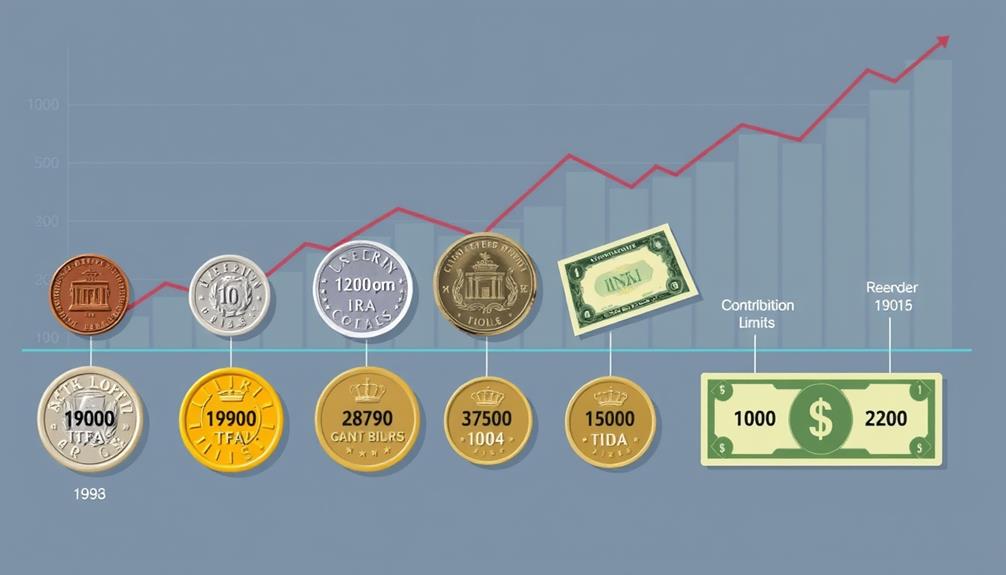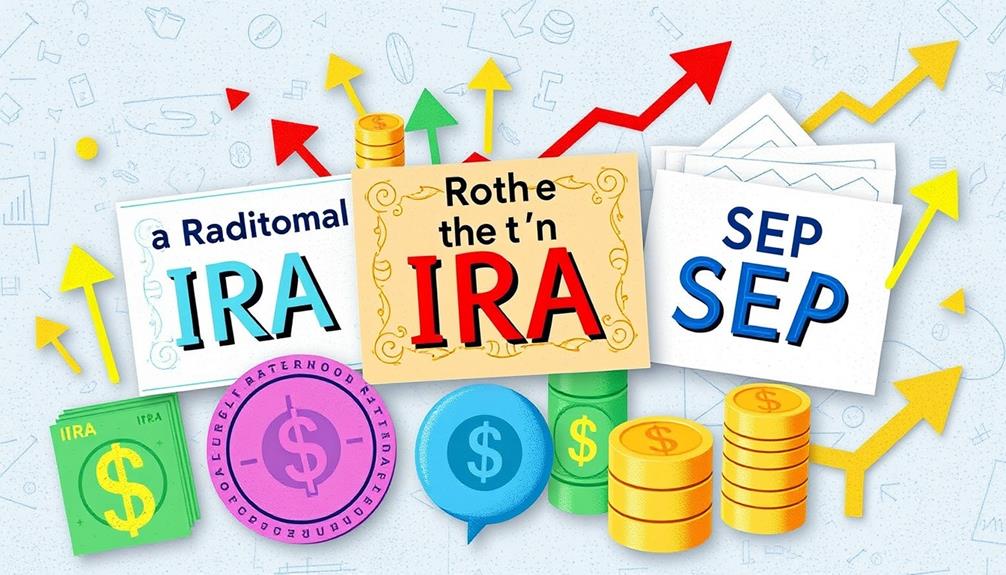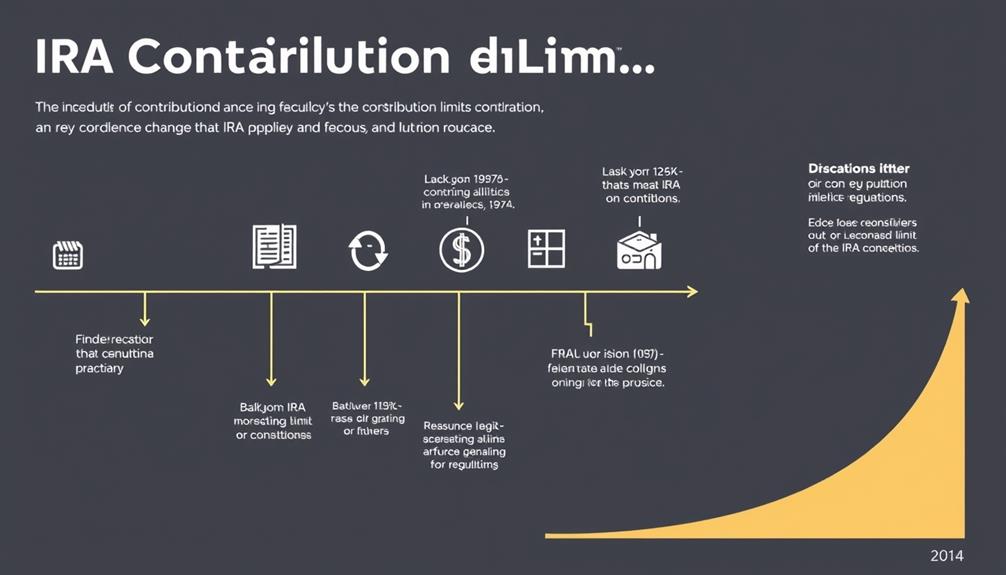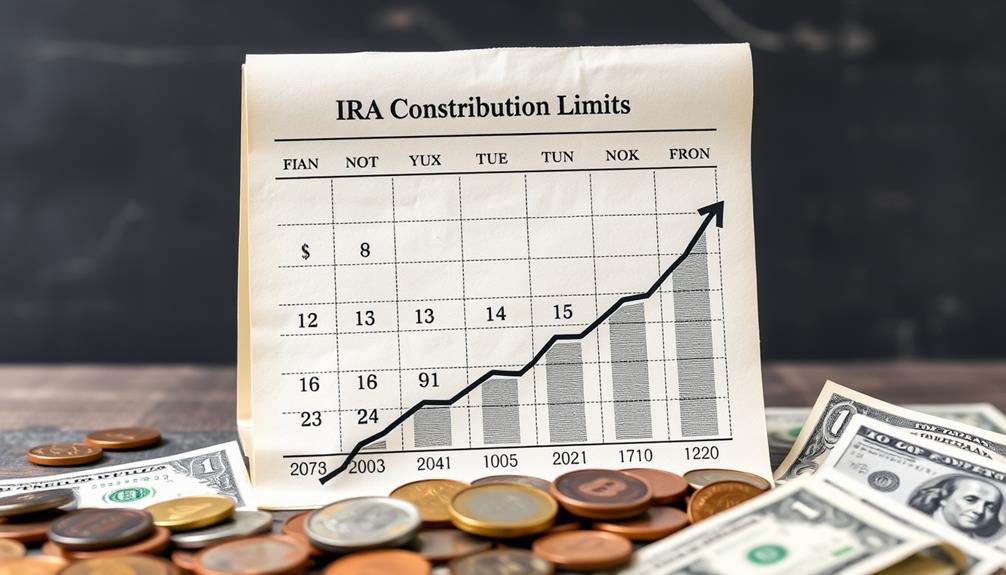IRA contribution limits have evolved over time, beginning at $1,500 in 1974 and reaching $6,500 in 2023, with potential further increases projected for 2024. These limits, which are adjusted for inflation, are designed to assist individuals in saving more for retirement. While Traditional and Roth IRAs share similar limits, individuals aged 50 and above are eligible for additional catch-up contributions. Looking ahead, the SECURE 2.0 Act could introduce new options and higher limits. Remaining informed can help improve your retirement strategy and savings. There is more to learn about these developments that may impact your future contributions.
Key Takeaways
- IRA contribution limits have consistently increased since 2001, with the 2023 limit at $6,500 and projected to rise to $7,000 in 2024.
- Traditional and Roth IRAs have a $1,000 catch-up contribution for individuals aged 50 and older to enhance retirement savings.
- The SECURE 2.0 Act may introduce significant changes to IRA contribution limits and options by 2025.
- Contribution limits are indexed to inflation, with adjustments based on CPI trends influencing future increases.
- As of 2023, approximately 42.2% of U.S. households own an IRA, highlighting its importance for retirement planning.
Historical Changes in Contribution Limits

The history of IRA contribution limits showcases considerable changes over the decades. Starting in 1974, the IRA contribution limit was set at $1,500, and it increased to $2,000 in 1982.
These historical changes reflect the need to adapt retirement accounts to economic realities, especially as various investment strategies, such as IRA rollover to gold, became more popular among investors seeking diversification.
Since 2001, contribution limits have been indexed to inflation, with permanent indexing established in 2006. This guarantees that as costs rise, your ability to save for retirement keeps pace.
In 2022, the IRA limit reached $6,000, which represented 8.1% of median household income at that time. Moving into 2023, the limit increased to $6,500, while the 401(k) limit stood at $22,500.
Looking ahead, the projected limits indicate further growth. For 2024, experts predict the IRA contribution limit will rise to $7,000, alongside a $23,000 limit for 401(k) plans.
These adjustments highlight the importance of staying informed about IRA contribution limits, whether you're investing in traditional or Roth IRAs, as they considerably impact your retirement savings strategy.
Types of Individual Retirement Accounts

When choosing an Individual Retirement Account, you'll want to evaluate the features of Traditional IRAs, the benefits of Roth IRAs, and the options available with Rollover IRAs.
Each type has its own advantages that can align with your financial goals and tax situation.
For instance, high customer service ratings from providers like Noble Gold can enhance your investment experience.
Understanding these differences will help you make informed decisions about your retirement savings.
Traditional IRA Features
Flexibility defines Traditional IRAs, making them an attractive option for retirement savings. One of the key features is the ability to make tax-deductible contributions, which can considerably lower your taxable income.
Additionally, understanding common financial terms associated with retirement accounts is essential for effective planning. Here's what you should know:
- The contribution limit for a Traditional IRA is $6,500 in 2023, increasing to $7,000 in 2024, with an additional catch-up contribution of $1,000 if you're 50 or older.
- There's no age limit for contributions, meaning even if you're 70½ or older, you can contribute as long as you have earned income.
- Keep in mind that if you're covered by an employer-sponsored retirement plan, your ability to deduct contributions might be limited based on your modified adjusted gross income (MAGI).
Withdrawals from a Traditional IRA are taxed as ordinary income. If you take money out before age 59½, you may face a 10% penalty unless you meet specific criteria.
Understanding these features can help you make informed decisions about your retirement savings strategy.
Roth IRA Benefits
Roth IRAs offer significant advantages for retirement savings, especially for those who expect to be in a higher tax bracket later in life. One of the key Roth IRA benefits is the ability to make tax-free withdrawals during retirement, as contributions are made with after-tax dollars.
In 2023, the contribution limits are $6,500, with an extra $1,000 catch-up contribution for individuals aged 50 and older, allowing for a total of $7,500. Additionally, diversifying retirement portfolios with investments like Gold IRAs can provide a hedge against inflation and economic downturns, further enhancing retirement savings strategies through Gold IRA benefits.
However, your eligibility for contributions may be affected by your modified adjusted gross income (MAGI), with higher earners facing reduced limits or complete ineligibility. Unlike traditional IRAs, Roth IRAs don't have required minimum distributions (RMDs) during your lifetime, giving you greater flexibility in your retirement planning.
This feature allows your investments to continue growing tax-free, maximizing the potential of compound interest over time. Roth IRAs can be particularly beneficial for younger investors, as they've a longer investment horizon for their contributions to grow.
Rollover IRA Options
Rollover IRAs open the door to efficient retirement planning by allowing you to transfer funds from employer-sponsored plans, like a 401(k), without facing immediate tax penalties. This makes it a savvy choice for consolidating your retirement accounts and streamlining your financial management.
Additionally, by considering options such as a Gold IRA, investors can diversify their retirement savings and protect against market volatility. Just keep in mind that you must complete the rollover process within 60 days to adhere to IRS guidelines and avoid taxation on the transferred amount.
When considering a rollover IRA, here are a few key points to remember:
- You can fund a rollover IRA with either traditional pre-tax contributions or Roth after-tax contributions, depending on the source of your rollover.
- Unlike other IRAs, rollover IRAs don't have annual contribution limits since they're funded by moving existing retirement assets, not new contributions.
- Consolidating multiple retirement accounts into a rollover IRA can simplify your financial management and potentially reduce fees.
Key Regulations Impacting Contributions

Understanding the key regulations that impact IRA contributions is vital for effective retirement planning. The IRS enforces annual IRA contribution limits to manage tax benefits, with a contribution amount of $7,000 for both traditional and Roth IRAs in 2024. If you're 50 or older, you can also make an additional catch-up contribution of $1,000.
It's important to take into account how different investment options, like Bitcoin IRAs, may affect your overall retirement strategy.
For traditional IRAs, your contributions may be fully deductible if neither you nor your spouse participates in a workplace retirement plan. However, your modified adjusted gross income (MAGI) can affect your deduction.
Meanwhile, Roth IRA contributions are subject to income phase-out ranges, which can limit your ability to contribute if you earn above certain thresholds.
It's essential to avoid excess contributions, as these incur a 6% penalty on the amount exceeding the limit. Additionally, the spousal IRA rules allow you to contribute on behalf of a non-working partner, provided you file jointly and meet the earned income requirement.
Staying informed about these regulations will help you maximize your retirement savings and avoid unnecessary penalties.
Trends in IRA Participation

With the landscape of retirement savings evolving, trends in IRA participation reveal important insights into how Americans are planning for their futures. As of 2023, about 42.2% of U.S. households own an IRA, showcasing a strong participation rate in retirement savings. Total IRA assets have soared to approximately $13 trillion, reflecting significant investments in these accounts.
This surge in IRA ownership can also be attributed to the increasing awareness of diversified investment options, such as Gold IRA Rollovers, which serve as a hedge against economic uncertainty.
Several key trends are shaping IRA participation:
- Increased financial literacy among younger generations is driving more people to explore their IRA options.
- A noticeable shift toward Roth IRAs over traditional IRAs indicates changing preferences in tax treatment and withdrawal flexibility.
- Rising household income has historically correlated with higher IRA contributions, underscoring the impact of economic conditions on savings behavior.
These trends highlight the growing importance of IRAs in retirement planning.
As you navigate your own financial future, understanding these patterns can help you make informed decisions about your retirement savings strategy. By staying aware of participation rates and the evolving landscape, you can better position yourself to take advantage of the opportunities that IRAs offer for building your financial security.
Strategies for Maximizing Contributions

Maximizing your IRA contributions is an essential step toward securing your financial future. If you're 50 or older, take advantage of catch-up contributions to boost your traditional or Roth IRA contributions by an extra $1,000, raising your total to $8,000 in 2024.
Regularly reviewing your contributions is vital, especially as the IRA contribution limit increases by $500 from 2023, reflecting inflation adjustments. Additionally, utilizing best websites to earn money online can provide extra funds to help reach your contribution goals.
If you have a non-working spouse, consider utilizing spousal IRAs. This allows couples aged 50 or older to contribute up to a combined limit of $14,000 in 2024.
For high-income earners facing contribution restrictions, the backdoor Roth IRA strategy can help you bypass income limits and still enjoy the benefits of Roth IRAs.
Keep an eye on IRS regulations, as excess contributions beyond the limit can lead to a 6% tax penalty. Staying informed on annual limits and compliance is key to optimizing your retirement savings.
Future Projections for Contribution Limits

As you look ahead to future IRA contribution limits, you'll want to take into account how inflation and legislative changes could impact your savings strategy.
The increasing focus on sustainability and responsible investing may also influence your long-term financial goals, as current trends in private equity could offer new opportunities for growth.
With the IRS set to announce adjustments based on CPI trends, it's vital to stay informed about potential increases.
Keep an eye on the SECURE 2.0 Act provisions, especially if you're nearing retirement age, as they could greatly affect your contribution options.
Anticipated Limit Adjustments
Anticipation surrounds the upcoming adjustments to IRA contribution limits, particularly with the SECURE 2.0 Act paving the way for significant changes in 2025.
As you plan for your retirement, it's essential to stay informed about these anticipated adjustments, especially given the growing demand for financial literacy in a technology-driven world. Understanding the implications of AI ethics in finance can also enhance your approach to investment and savings strategies.
The IRS is expected to announce updated contribution limits in late 2024, reflecting the latest consumer price index (CPI) data.
Here are some key points to bear in mind:
- For 2025, catch-up contribution limits for individuals aged 60-63 will increase to either $10,000 or 150% of the regular limit, adjusted for inflation.
- The IRA contribution limit for 2024 remains at $7,000 for those under 50, and future limits may rise based on CPI adjustments.
- Historical data shows that contribution limits have consistently increased since 2001, responding to inflation trends.
Understanding these changes can help you maximize your retirement plans.
Keep an eye on the IRS announcements, as they'll provide clarity on how you can benefit from these anticipated adjustments in your strategy for 2025 contributions.
Inflation Impact Analysis
Understanding how inflation affects IRA contribution limits can greatly impact your retirement planning. Since these limits are indexed to inflation, established in 2006, you can expect annual adjustments based on the Consumer Price Index (CPI).
As of March 31, 2024, the inflation rate was reported at 3.5%, which will influence the calculations for the 2025 contribution limits. Historical trends indicate an annual CPI change of 3.7% as of September 30, 2023, suggesting potential increases in future IRA contribution limits.
For those aged 60-63, the 2025 catch-up contribution limit is projected to be either $10,000 or 150% of the regular catch-up limit, depending on inflation adjustments.
The IRS limits for 2025 are anticipated to be released in October or November 2024, following the analysis of CPI data from the fiscal year 2024.
Legislative Changes Forecast
With the passage of the SECURE 2.0 legislation, you can expect significant changes to IRA contribution limits starting in 2025. This legislation introduces new provisions, particularly for those aged 60 to 63, allowing catch-up contributions to be the greater of $10,000 or 150% of the regular limit, adjusted for inflation trends.
Here's what to look forward to regarding the 2025 limits:
- Contribution limits will be based on adjustments from the 2024 limits using consumer price index (CPI) data.
- The IRS is expected to finalize these contribution limits around October or November 2024.
- Historical average annual CPI changes, noted at 2.6%, will influence these future projections.
The legislative changes won't only impact your ability to save more as you approach retirement but will also reflect ongoing economic conditions.
Keep an eye on inflation trends, as they'll play a vital role in determining your IRA contribution limits. By staying informed, you can better plan your retirement savings strategy to maximize your financial future.
Implications of Recent Legislation

Recent changes in legislation, particularly with the SECURE 2.0 Act, greatly reshape how you can approach your IRA contributions. This act, effective in 2024, notably impacts your retirement savings strategy.
For those aged 60-63, the catch-up contribution limit increases to the greater of $10,000 or 150% of the standard limit, allowing you to boost your savings as you near retirement.
If your income exceeds $145,000, you'll need to make these catch-up contributions on a Roth basis, meaning you'll pay taxes upfront. This shift guarantees higher earners contribute their fair share to retirement savings.
Additionally, the SECURE 2.0 Act removes the previous age limit for contributions to traditional IRAs, enabling you to keep contributing beyond age 70½, provided you have earned income.
Moreover, for small business employees, the annual limit for SIMPLE IRAs rises to $16,000 in 2024, enhancing savings opportunities.
You should also keep an eye out for anticipated adjustments to contribution limits based on inflation, expected to be released in late 2024, as these changes will further influence your retirement planning.
Factors Influencing Contribution Decisions

Often, personal financial circumstances considerably influence your decisions about IRA contributions. As you evaluate how much to contribute, consider several key factors:
- Earned Income: Your income level directly affects your eligibility for certain IRA types and contribution limits.
- Tax Implications: Understanding the tax consequences of your contributions can help you decide between a traditional IRA and a Roth IRA contribution.
- Retirement Goals: Aligning your contributions with your long-term financial objectives guarantees you're on track for a comfortable retirement.
If you're aged 50 or older, you can take advantage of catch-up contributions, raising your total limit to $8,000 in 2024.
However, keep in mind that higher income levels might restrict your ability to make direct Roth IRA contributions. In such cases, the Backdoor Roth IRA can be a strategic alternative to maximize your contributions.
Regularly reviewing IRS guidelines and staying compliant with annual limits is vital to avoid penalties.
Frequently Asked Questions
Will IRA Contribution Limits Increase in 2024?
Yes, IRA contribution limits will increase in 2024. You can contribute $7,000 if you're under 50, and if you're 50 or older, you can add an extra $1,000 for a total of $8,000.
What Is the 2025 IRA Contribution Limit?
Historically, IRA contribution limits increase about 2-3% annually. For 2025, you'll see adjustments based on 2024's $7,000 limit, influenced by inflation and any new regulations released by the IRS in late 2024.
When Should You Stop Contributing to an Ira?
You should stop contributing to an IRA if your income exceeds the limits for Roth contributions, or if you're receiving required minimum distributions from other accounts. Regularly review your financial goals to decide.
What Are the Maximum IRA Contribution Limits Historical?
Like a growing tree, IRA contribution limits have evolved. Starting at $1,500 in 1974, they've climbed to $6,500 in 2023. By 2024, expect them to reach $7,000, encouraging your retirement savings journey.
Conclusion
As you navigate the ever-changing landscape of IRA contribution limits, think of your retirement savings as a garden waiting to bloom. By understanding past changes and anticipating future trends, you can plant the seeds of financial security today. Stay informed about regulations and strategies that can help your contributions flourish. With the right knowledge and planning, you'll cultivate a robust nest egg that stands tall against the test of time, ensuring a vibrant future for you and your loved ones.
Helen brings a wealth of experience in investment strategy and a deep passion for helping individuals achieve their retirement goals. With a keen understanding of market dynamics, Helen has been instrumental in shaping the vision and direction of Gold IRA Markets. She specializes in creating innovative solutions that align with our clients’ long-term investment objectives.










